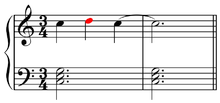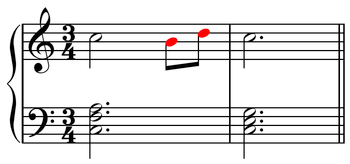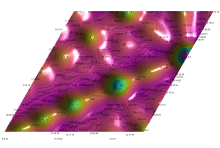Nonchord tone

A nonchord tone (NCTs), nonharmonic tone, or embellishing tone is a note (i.e., a pitch) in a piece of music or song that is not part of the implied or expressed chord set out by the harmonic framework. Similarly, a chord tone is a note that is a part of the functional chord (see: factor (chord)). Nonchord tones are most often discussed in the context of the common practice period of classical music, but they can be used in the analysis of other types of tonal music as well, such as Western popular music.
Chord and nonchord tones are defined by their membership (or lack of membership) in a chord: "The pitches which make up a chord are called chord-tones: any other pitches are called non-chord-tones."[1] They are also defined by the time at which they sound: "Nonharmonic tones are pitches that sound along with a chord but are not chord pitches."[2] For example, if an excerpt from a piece of music implies or uses a C Major chord, then notes C,E and G are members of that chord, while any other note played at that time (e.g., notes such as F#) is a nonchord tone. Such tones are most obvious in homophonic music but occur at least as frequently in contrapuntal music.
"Most nonharmonic tones are dissonant and create intervals of a second, fourth or seventh",[2] which are required to resolve to a chord tone in conventional ways. If the note fails to resolve until the next change of harmony, it may instead create a seventh chord or extended chord. While it is theoretically possible that for a three-note chord there are (in equal temperament) nine possible nonchord tones, nonchord tones are usually in the prevailing key. Augmented and diminished intervals are also considered dissonant, and all nonharmonic tones are measured from the bass, or lowest note sounding in the chord except in the case of nonharmonic bass tones.[2]
Nonharmonic tones generally occur in a pattern of three pitches, of which the nonharmonic tone is the center:[2]
| 1 | – | 2 | – | 3 |
|---|---|---|---|---|
| Preceding tone | – | Nonharmonic tone | – | Following tone |
| (chord tone) | – | – | (chord tone) | |
| Preparation | – | Dissonance | – | Resolution |
Nonchord tones are distinguished through how they are used. The most important distinction is whether they occur on a strong or weak beat and are thus accented or unaccented.[2] They are also distinguished by their direction of approach and departure and the voice or voices in which they occur, and the number of notes they contain.
Over the centuries of music history, tones which where considered to be nonchord tones became to be viewed as chord tones, such as the seventh in a seventh chord. In 1940s-era Bebop jazz, tones which were previously considered to be nonchord tones, such as playing an F# note with a C 7 chord, became to be viewed as chord tones (in this example, the F# would be analyzed as a sharp eleventh chord, or C7 (#11)). In European classical music "The greater use of dissonance from period to period as a result of the dialectic of linear/vertical forces led to gradual normalization of ninth, eleventh, and thirteenth chords[in analysis and theory]; each additional non-chord tone above the foundational triad became frozen into the chordal mass."[3]
Certainly no one doubts the need for embellishments....They are indeed indispensable, for consider their uses. They connect notes, animate them, lend them a special effect and weight when required, make them pleasing and thus arouse a particular attentiveness. Embellishments help to clarify the content of the notes—be it sad, joyful, or of other nature....
Unaccented
Anticipation
An anticipation (ANT) occurs when this note is approached by step and then remains the same. It is basically a note of the second chord played early. The Dissonant (note "b", 7th degree of scale C Major) in bar 1 is approached by step and resolves when that same pitch becomes a chord tone in bar 2.
Neighbor tone

A neighbor tone (NT) or auxiliary note (AUX) is a nonchord tone that passes stepwise from a chord tone directly above or below it (which frequently causes the NT to create dissonance with the chord) and resolves to the same chord tone:

In practice and analysis, neighboring tones are sometimes differentiated depending upon whether or not they are lower or higher than the chord tones surrounding them. A neighboring tone that is a step higher than the surrounding chord tones is called an upper neighboring tone or an upper auxiliary note while a neighboring tone that is a step lower than the surrounding chord tones is a lower neighboring tone or lower auxiliary note. However, following Heinrich Schenker's usage in Free Composition, some authors reserve the term "neighbor note" to the lower neighbor a half step below the main note.[6]
The German term Nebennote is a somewhat broader category, including all nonchord tones approached from the main note by step.[6]
Incomplete neighbor tone
An incomplete neighbor tone (IN) is a neighbor tone that has only one stepwise connection with a consonant chord tone (instead of the normal two), the other connection being a skip. Thus, instead of leaving a chord tone with a step up or down and returning to the same chord tone in like manner, one of the chord tones is left out (or skipped over) so the neighbor tone is only connected to one of the chord tones making it incomplete.
IN's are generally written either:
- With a skip away from a harmony tone to a non-chord tone, and resolved with a step back to a harmony tone (usually in the opposite direction from the approach).
or - With a step away from a harmony tone to a non-chord tone, and resolved with a skip back to a harmony tone (also usually in the opposite direction from the approach).
Escape tone

An escape tone (ET) or echappée is a particular type of unaccented incomplete neighbor tone that is approached stepwise from a chord tone and resolved by a skip in the opposite direction back to the harmony.
Passing tone

A passing tone (PT) or passing note is a nonchord tone prepared by a chord tone a step above or below it and resolved by continuing in the same direction stepwise to the next chord tone (which is either part of the same chord or of the next chord in the harmonic progression). Where two non-chord notes are before the resolution they are double passing tones or double passing notes.
Accented
Passing tone
As with above but on an accented beat.

Neighbor tone
A neighbor tone where you step up or down from the chord tone, and then move back to the chord tone.[8]
Suspension


Endeavor, moreover, to introduce suspensions now in this voice, now in that, for it is incredible how much grace the melody acquires by this means. And every note which has a special function is rendered audible thereby.
A suspension (SUS) (sometimes referred to as a syncope[9]) occurs when the harmony shifts from one chord to another, but one or more notes of the first chord (the "Preparation") are either temporarily held over into or are played again against the second chord (against which they are nonchord tones called the "Suspension") before resolving downwards to a chord tone by step (the "Resolution"). Note that the whole process is called a suspension as well as the specific non-chord tone(s):
Suspensions may be further described using the number of the interval forming the suspension and its resolution; e.g. 4-3 suspension, 7-6 suspension, or 9-8 suspension. Suspensions must resolve downwards; if a tied note is prepared like a suspension but resolves upwards, it is called a retardation. A suspension must be prepared with the same note (in the same voice) using a chord tone in the preceding chord; otherwise it is an appoggiatura.

Decorated suspensions are common and consist of portamentos or double eighth notes, the second being a lower neighbor tone.
A chain of suspensions constitutes the fourth species of counterpoint; an example may be found in the second movement of Arcangelo Corelli's "Christmas Concerto".
Appoggiatura

An appoggiatura (APP) is a type of accented incomplete neighbor tone approached skip-wise from one chord tone and resolved stepwise to another chord tone ("overshooting" the chord tone).
Portamento

A portamento is the late Renaissance precursor to the anticipation,[11] though today it refers to a glissando.
Nonharmonic bass

Nonharmonic bass notes are bass notes that are not a member of the chord below which they are written.
Examples include the Elektra chord.[13] See also: pandiatonic.
Involving more than three notes
Changing tones
Changing tones (CT) are two successive nonharmonic tones. A chord tone steps to a nonchord tone which skips to another nonchord tone which leads by step to a chord tone, often the same chord tone. They may imply neighboring tones with a missing or implied note in the middle. Also called double neighboring tones or neighbor group.[2]

Pedal point
Another form of nonchord tone is a pedal point or pedal tone (PD) or note, almost always the tonic or dominant, which is held through a series of chord changes. The pedal point is almost always in the lowest voice (the term originates from organ playing), but it may be in an upper voice; then it may be called an inverted pedal. It may also be between the upper and lower voices, in which case it is called an internal pedal.

Chromatic nonharmonic tone

A chromatic nonharmonic tone is a nonharmonic tone that is chromatic, or outside of the key and creates half-step motion. The use of which, especially chromatic appoggiaturas and chromatic passing tones, increased in the Romantic Period.[14]
See also
Sources
- ↑ Kroepel, Bob (1993). Mel Bay Creative Keyboard's Deluxe Encyclopedia of Piano Chords: A Complete Study of Chords and How to Use Them, p.8. ISBN 978-0-87166-579-9. Emphasis original.
- 1 2 3 4 5 6 Benward & Saker (2003). Music: In Theory and Practice, Vol. I, p.92. Seventh Edition. ISBN 978-0-07-294262-0.
- ↑ "Debussy and the Crisis of Tonality", p.72. Author(s): Roland Nadeau. Source: Music Educators Journal, Vol. 66, No. 1, (Sep., 1979), pp. 69-73. Published by: MENC: The National Association for Music Education.
- ↑ Forte, Allen (1979). Tonal Harmony in Concept & Practice, p.388. ISBN 0-03-020756-8.
- ↑ Jonas, Oswald (1982) Introduction to the Theory of Heinrich Schenker (1934: Das Wesen des musikalischen Kunstwerks: Eine Einführung in Die Lehre Heinrich Schenkers), p.89. Trans. John Rothgeb. ISBN 0-582-28227-6.
- 1 2 William Drabkin. "Non-harmonic note". In L. Root, Deane. Grove Music Online. Oxford Music Online. Oxford University Press. (subscription required)
- 1 2 Jonas (1982), p.94.
- ↑ "Nonharmonic Tones".
- 1 2 3 Jonas (1982), p.96.
- ↑ Forte (1979), p.304.
- ↑ Benward & Saker (2009). Music in Theory and Practice, Vol. II, p.8. ISBN 978-0-07-310188-0.
- ↑ Andriessen, Louis & Schönberger, Elmer (2006). The Apollonian Clockwork: On Stravinsky. Amsterdam University Press. ISBN 9789053568569.
- ↑ Lawrence Kramer. "Fin-de-siècle Fantasies: Elektra, Degeneration and Sexual Science", Cambridge Opera Journal, Vol. 5, No. 2. (Jul., 1993), pp. 141-165.
- 1 2 Benward & Saker (2009), p.217-18.
